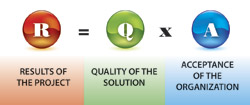A common definition of organizational culture is “the sum of the habits of the organization.” We all know how hard it is to change a personal habit. Take your own exercise habits, for example. Most of us resolve to exercise more, and maybe even follow through with a few strenuous workouts. But few of us work out with the same vigor two or three weeks later.
So when it comes to changing the habits of many people in our organizations, we shouldn’t be surprised when we experience initial improvement from change projects, only to then experience a decline in results in the weeks and months that follow.
For many years, we have grown to appreciate and understand that the sustained results of an improvement project are dependent not just upon the quality of the improvement (solution), but also the acceptance of the change by the organization. This visual illustrates the concept:

However, yesterday’s change management practices, which were designed to boost acceptance, left a bad taste in the mouths of objective-focused company leadership. Team-building activities, active listening and asking staff to read Who Moved My Cheese? were the practices du jour. We knew that addressing the human side of change was important, but actually managing it has always seemed to be unpredictable and outside our capabilities.
There’s good news. Today’s change management is a well-defined process. There are organizations which have dedicated years to researching the best practices of successful leaders of change, and measuring the benefits of this once-uncomfortable practice.
The research is astounding. Companies who practice effective change management are 71 percent more likely to achieve and sustain their objectives than those that minimize the people side of change. Top that off with the fact that those same companies are 55 percent more likely to be on or ahead of schedule in their efforts to accomplish their business goals.
We can put it into perspective by comparing companies A and B, both of whom were implementing a change in operations to meet the demands of a key customer:
Company A formed a change management team. They assessed gaps in their company’s ability to accept and adopt change. They built a change management plan, constructed a targeted communications plan, coached their leaders, and acknowledged the obstacles and resistance they were likely to confront. They used reinforcement techniques to celebrate successes and audit their progress.
Company B talked about the important new responsibilities employees would bear. They held meetings to teach the employees about new procedures. They included a few articles about the change in their monthly newsletter.
So, what happened? The Company A project team met their objectives within the desired timeframe and recouped the cost of the project ahead of schedule. Conversely, Company B is still struggling to get employees to do things differently. By definition, they’ve changed, but the “thinking” and commitment to improvement is clearly not in place. Company B’s project team is behind schedule, and the company has exceeded the budget to provide additional training to push the effort forward.
The takeaway: without rigorous focus on gaining the acceptance (and accountability) of the employees, plans are doomed to fail. iBi


